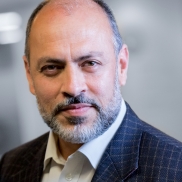You know the old children rhyme about sticks and stones. Well, it’s wrong. Words most certainly can hurt, and they can inspire other people to take threatening actions. The signs of growing political polarisation are all around us.
Three days ago: Calgary neo-Nazi group claimed responsibility for hanging racist banner over Macleod Trail. Four days ago: There was QAnon-inspired protest in Peterborough. A week ago, it was reported that white supremacist symbol on a Calgary Stampede rodeo outfit.
Social media platforms have a major role in fuelling divisions and spreading false narratives for years. That has led to an explosion of hatred against the “invading” “people of colour” who are here to replace White people.
Our youth get indoctrinated into conspiracies to the point where they decide to commit violence.
I have been studying hate movements for many years now. It is alarming because it’s almost like studying landmines, recognising that there are landmines in our digital infrastructure that will go off at some point. Politicians using similar racist language and farming draw more people to them and make them more likely to go off.
As a society, we must be committed to figuring out how to excavate and get rid of those landmines so that they are not radicalising more people into violence.
People need to be responsible for their words as well as their actions. Many politicians deviate from the real issues and discuss issues that divide people after finding scapegoats. That comes with a hefty price tag of violence against minorities. There is a direct correction in what the politicians say and the violence against the minorities.
It is very dangerous. Wherever you turn a complex group of people into a caricature, into an “invading” force, they lose their humanity. Without humanity, they easily become a threat, and most importantly, if you enact violence on them, you are engaging in self-defence.
We see the theme in cases across the board with these racist, hateful manifestoes of mass shooters. They are shooting people in churches, synagogues and shopping malls – people who are going about their day. But in the shooter’s mind, they are potentially evil. They are dangerous, and the shooter himself engages in self-defence and a heroic act. You don’t get there without stereotypes and dehumanising rhetoric.
Social media can do a lot. Unfortunately, no solution will come from the parliament. Parliament is decades behind in terms of regulating social media and tech companies.
The most successful efforts have come from community campaigns to de-platform radical and dangerous websites, often targeting the tech companies that would allow those websites to be visible and gain viewership. And the second is social media.
Social media companies have found out how to use algorithms to attract our interest. It’s the same algorithm that can lead people into very radical and anti-democratic ideas.
Perhaps the biggest boon to organised racism and hate speech in decades, as they help racist ideas find a much larger and potentially receptive audience. The companies that helped these supremacist movement expand can now help limit its impact.
Addressing online hate requires a multi-prong collective approach in which, of course, government regulations, community campaigns, media awareness and educational programs would play a key role. However, social media companies can also play their role by putting energy, time and resources into stopping conspiracies and hate speech from spreading. If someone says something hateful on the internet and doesn’t have an audience, it’s not that dangerous, and it would not motivate others to continue spewing hate. Social media companies know exactly how to do that.




Comments
droversointeru
Wow, fantastic weblog structure! How lengthy have you ever been running a blog for? you made blogging glance easy. The total glance of your web site is great, let alone the content material!